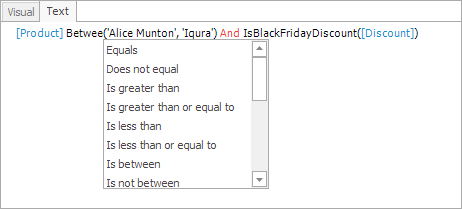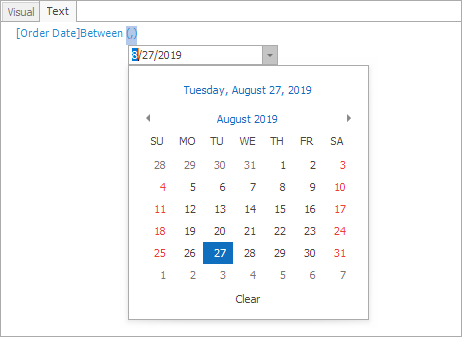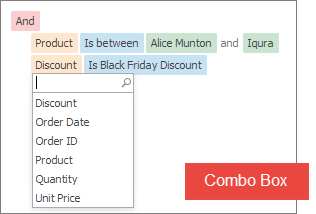FilterEditorControl Class
Allows users to build filter criteria and apply them to controls and data sources. Supports visual and text criteria edit modes.
Namespace: DevExpress.XtraFilterEditor
Assembly: DevExpress.XtraRichEdit.v20.1.dll
NuGet Package: DevExpress.Win.RichEdit
Declaration
public class FilterEditorControl :
BaseStyleControl,
ISyntaxHighlightService,
IDisposable,
IFilterControl,
IFilterControlOwner,
IFilterControlGetModel,
ISupportEditorTextConverterRemarks
The FilterEditorControl allows users to build a filter criterion and apply it to the attached control or data source. The control supports visual and text criteria edit modes.

Note
Run the XtraGrid demo to try out the DataAccess.UI.FilterEditorControl.
The DataAccess.UI.FilterEditorControl arranges edit modes into two horizontal panels, whereas the obsolete XtraFilterEditor.FilterEditorControl arranges them into two tabs. The DataAccess.UI.FilterEditorControl is backward compatible with the XtraFilterEditor.FilterEditorControl.
Since version 18.1, the filter editor in the grid control, in the tree list, and other data-aware controls uses the DataAccess.UI.FilterEditorControl. Disable the static (Shared in VB) WindowsFormsSettings.UseAdvancedFilterEditorControl property to use the XtraFilterEditor.FilterEditorControl.
Binding to Source Control
The SourceControl property specifies the data control or data source to which the FilterEditorControl is attached.
When the filter criteria changes in the source control (for example, by the user or in code), the FilterEditorControl automatically reflects the changes.
Filter Criteria
The FilterCriteria property gets or sets the CriteriaOperator object that specifies the filter criteria. The FilterString property specifies the string expression that corresponds to the filter criteria. See Criteria Language Syntax for more information.
When the filter criteria changes, the FilterEditorControl does not automatically apply it to the source control. Call the ApplyFilter() method to apply the filter criteria.
Visual and Text Edit Modes
The ViewMode property specifies whether to enable the Visual and/or Text edit mode.


In Text mode, the control highlights syntax and suggests operators.

Corresponding editors are used to edit values.

Visual and Text Criteria Display Stlye
In Visual edit mode, the static (Shared in VB) WindowsFormsSettings.FilterCriteriaDisplayStyle property specifies whether to enable the Visual or Text criteria display style.


Pop-up Menu or Combo Box to Edit Operators and Operands
The UseMenuForOperandsAndOperators property specifies whether to use a pop-up menu or a combo box to edit operators and operands. The combo box displays a search box in the drop-down list and the vertical scroll bar (when the item count exceeds the list’s capacity).


Unbound Mode
You can also use the FilterEditorControl even if it is not bound to a source control (the SourceControl property equals null). Users can build filter criteria that you can get from the FilterCriteria or FilterString property. In unbound mode, populate the FilterColumns collection with columns by which data should be filtered (this collection is populated automatically in bound mode).